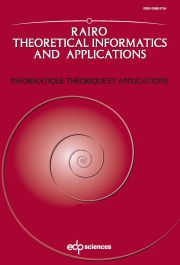No CrossRef data available.
Article contents
A new algebraic invariant for weak equivalence of sofic subshifts
Published online by Cambridge University Press: 03 June 2008
Abstract
It is studied how taking the inverse image by a sliding block code affects the syntactic semigroup of a sofic subshift. The main tool are ζ-semigroups, considered as recognition structures for sofic subshifts. A new algebraic invariant is obtained for weak equivalence of sofic subshifts, by determining which classes of sofic subshifts naturally defined by pseudovarieties of finite semigroups are closed under weak equivalence. Among such classes are the classes of almost finite type subshifts and aperiodic subshifts. The algebraic invariant is compared with other robust conjugacy invariants.
- Type
- Research Article
- Information
- RAIRO - Theoretical Informatics and Applications , Volume 42 , Issue 3: JM'06 , July 2008 , pp. 481 - 502
- Copyright
- © EDP Sciences, 2008


